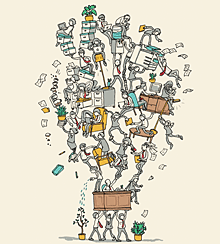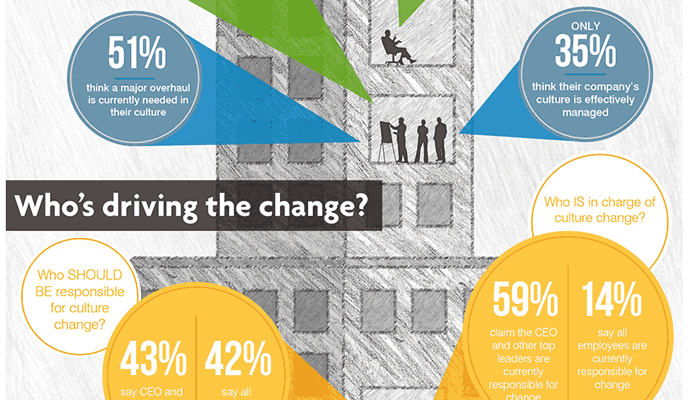The Critical Few: Components of a Truly Effective Culture
Forget the monolithic change management programs and focus on the elements of your culture that drive performance.
Sometimes corporate culture manifests itself in a make-your-own-taco party in the office kitchenette. Sometimes you can see it when an outdated phone bank is converted into an on-site ice cream shop. And sometimes it’s on display when senior leaders pick up paintbrushes to turn formerly bland office walls into electric blue work spaces. These are examples of the “Culture Blitz” at work at Southwest Airlines Company, where a 40-year culture is still going strong and is further invigorated by traveling teams who volunteer every year to visit hundreds of employees to show their appreciation. And it’s infectious.
Mary Widen is a Southwest Culture Blitz member who will never forget the first time she “hokeyed” an airplane. (Although the hokey is in fact a line dance, at Southwest it’s also the name of the small carpet sweeper used to clean the plane between flights.) It’s traditionally the responsibility of the flight attendants to clean the plane, but once in a while Culture Blitz members take over this task and give the flight attendants time off and bags of snacks. “The flight attendants were in shock—you would have thought I had given them a bag of jewelry. They were yelling ‘thank you’ at me long after I had walked away. It was their unexpected good moment of the week, and they were so grateful. And that refuels you. And those good feelings last long after the hokeying is complete. People keep in touch after, and that makes Southwest feel like a real family,” says Widen.
These are the types of experiences that a strong culture creates. To sustain such a culture, Southwest and other enterprises understand that key behaviors have to be actively managed and made visible. Companies with the most effective culture seek out and continually reinforce what Charles Duhigg, author of The Power of Habit: Why We Do What We Do in Life and Business (Random House, 2012), calls “keystone habits.” A keystone habit, Duhigg has noted, is “a pattern that has the power to start a chain reaction, changing other habits as it moves through an organization.” Companies that recognize and encourage such habits stand to build cultures with influence that goes beyond employee engagement and directly boosts performance.
Too few leaders recognize the outsized influence of these key behaviors, however. Their efforts to improve performance remain ill focused and diffuse. They find it hard to resist the temptation to pile one directive on top of another; even when those efforts are aligned to the same ultimate goals, they often undermine one another. Further, when those efforts are focused on significant changes to the culture, they are almost always too comprehensive, programmatic, esoteric, and urgent. Leaders fail to appreciate how deeply culture can be ingrained in people’s beliefs and habits—and, therefore, how very difficult it will be to change behavior in a way that will last.
We have found, through numerous cultural interventions with a wide range of organizations, from HP and Bell Canada to major enterprises in India, Australia, and the Middle East, that companies that eschew all-encompassing culture change initiatives and instead focus on three specific elements—critical behaviors, existing cultural traits, and critical informal leaders—have the most success. We call these “the critical few.”
The first elements, critical behaviors, are those ways of doing things in your current operations that can easily spread from one employee to another; they have the potential to generate a real business impact, particularly when they become habitual and widespread. Moreover, you would recognize them right away if respected leaders at various levels throughout the organization started putting them into practice.
The second piece, existing cultural traits, refers to three or four emotional elements of the current culture that are distinctively clear, wisely profound, emotionally powerful, and widely recognized; these traits together are a manifestation of the organization’s collective sense of identity. They play a prominent role in supporting the most important behaviors.
And the critical informal leaders are those few authentic individuals who motivate others by what they do and how they do it. They are recognized by their colleagues as credible, trustworthy, and effective—and they know how to influence behavior.
In our experience, a sharp focus on the critical few reduces complexity and begets more positive, informal, and lasting cultural impact on performance—and it does so much faster than top-down messaging and formal programmatic attempts. This approach takes into account the emotional dimension of human behavior. Most people instinctively resist change, particularly when it is thrust upon them in large doses, because it feels different and complex, and makes them uncomfortable. Top-down messaging alone—no matter how compelling and inspiring—seldom produces a lasting effect on how we feel about what we do.
Top-down messaging alone—no matter how compelling and inspiring—seldom produces a lasting effect on how we feel about what we do.
Individuals are simultaneously emotional and rational, so how we feel about something often gets in the way of how we think about it. This is particularly the case when human beings are confronted with complexity. When it comes to changing something important about what we do and how we do it, we crave simplicity so we can navigate the fear of the new and unknown—and it really helps when we can look to peers and colleagues for insight, support, and encouragement, if not positive personal experience. When people we trust and admire clearly model and encourage a few key behaviors, those behaviors spread much more quickly, and they stick.
If you don’t have your culture firmly established, a taco party or a hokey won’t get you there. But if you get these three critical elements in sync, your culture’s positive impact will be felt on the bottom line much sooner than you might expect.
Identify the Critical Behaviors
Pinpointing a few critical behaviors is priority number one. Once the behaviors that embody the cultural priorities that a company seeks are identified, clarified, and supported widely, you can focus on harnessing them to strengthen and modify the existing culture. But even while we focus first on the critical behaviors, you will see just how interwoven the elements of the critical few are.
As you set out to find and prioritize those critical behaviors that are going to make the biggest difference in performance, it might be tempting to address the ones that are holding you back, meaning those you most want to change or eliminate. You’ll be tempted to take on the biggest pain point, the behavioral elephant in the room—be it a lack of innovation, people not giving honest feedback to colleagues, or employees resisting collaboration with people outside their own teams.
Instead, take stock of the positive aspects of your current culture and consider which elements could be harnessed to drive the behaviors you seek most. At the same time, ask yourself:
- How visible would these behaviors be if a senior executive or an authentic informal leader started exhibiting them? (Would others throughout the organization see and recognize the change?)
- Will these behaviors be contagious enough to be spread through social networks and peer relationships? (Will key people begin to envy and emulate them?)
- What potential do the behaviors have to create real, measurable business impact? (Can you find ways to measure and track the impact early on?)
At the start of Southwest’s entrepreneurial journey, cofounder Herb Kelleher and his top team were determined to sustain a culture based on a few very simple, coherent behaviors that aligned with their low-cost route strategy: (1) cultivate collaborative and fun interactions across the company; (2) make every traveler feel good and enjoy personal interactions with Southwest people; (3) follow through on every traveler concern, and tell it like it is when the unexpected occurs; and (4) do it all on the cheap.
Kelleher’s simple strategy and operating model for Southwest Airlines was tightly connected with what soon became a remarkably instinctive culture. It has energized caring behaviors among employees, delighted target customers, and rewarded early shareholders. Kelleher believed (and his successors still maintain) that how you treat your employees determines how they treat customers—and happy customers are what will sustain attractive shareholder returns over time. Southwest flipped the hierarchy that most organizations follow— i.e., shareholders first, customers second, and employees last. Although the culture continues to evolve over time, it remains closely aligned with this simple formula.
Shaping a corporate culture is much easier to do when an enterprise is starting out small, as when Kelleher laid the cultural groundwork at Southwest. But no matter the organization’s size or level of maturity, shaping culture takes insight, persistence, and courage from leaders at multiple levels, especially when they are expecting culture to drive growth. It helps if leaders’ cultural intent is both simple and behaviorally clear, as Kelleher’s has been: Hire people who are naturally friendly and fun, make sure they learn how to connect in positive ways with customers, and discipline them to be relentlessly frugal. In retrospect, these have been the critical few behaviors that have produced the lowest fares and among the most satisfied and loyal customers in the U.S. airline industry for nearly 40 years.
Honor the Existing Culture
Your organization may have many admirable cultural traits, but you need to focus on those three or four traits that are distinctively clear, wisely profound, emotionally powerful, and widely recognized. If you go mining for more, not only will you hit rapidly diminishing returns, but you will also make even the strongest traits seem somehow tenuous, and the entire process will lose credibility.
It is a leader’s responsibility to determine the existing cultural traits that the organization will preserve and build upon. At one industrial manufacturer, the CEO enlisted a senior culture team to help him catalyze key existing traits similar to those many aspire to: speed, sensible risk, accountability, and customer-centricity. In another example, for a leading energy company in the U.S., unveiling significant traits—which the company termed “performance imperatives”—was a process of broader management team discussion and discovery. The performance imperatives were resourceful execution, enterprise-wide perspective, active accountability, and people development.
Almost every organization has a few key cultural traits that are distinctively positive. Whether these elements are displayed on posters in the corridors or etched on desk ornaments—or not visibly celebrated at all—they are an integral part of the company’s true cultural situation. Properly recognized and drawn upon, they provide the workforce a sense of pride and purpose.
But even after the priority traits have been declared, senior leaders can’t expect them to immediately inspire the right behaviors, in the right way, at the right time. When employees hear about the traits, they need to be able to recognize and personalize them. The traits need to feel specific to the real world people work in every day. Getting to this point is a process.
Begin by prioritizing your existing cultural traits on the basis of relevance, importance, and urgency. In addition, it is essential to shape, validate, and refine them using the insights and reflections of informal leaders in key populations. These individuals are often found on or close to the front line, and they have a strong and genuine connection with other employees. Use this combined leadership wisdom to decide what you want to accomplish most urgently, and carefully consider what makes sense at this stage of your company’s life cycle. Addressing these issues will help you home in on the cultural traits that are most important for your organization to pay attention to now.
Focus on the Critical Informal Leaders
You’ve picked the behaviors you need to change or energize. You understand which facets of your existing culture can help spread the new behaviors you are seeking. Now, focus your efforts on a critical few groups and specific people within the organization who can help bring this transformation about and make it last.
Since culture is the self-sustaining pattern of behaving, thinking, believing, and feeling in a given population, you are simply not going to change very much about it very rapidly. You will be similarly frustrated if you try to start with the people who most ardently object to what you’re trying to achieve. Instead, be laser-focused and pick the corners of your organization where there is both a need and a willingness to grapple with culture and where a spreading of your critical few behaviors could translate into real business impact. You are looking for a manager and team who “get it,” “need it,” and “want it.”
Next, within that team, enlist some “special forces” you can work with—people who are recognized by their colleagues as credible, informal leaders and who exemplify one or more of your critical few behaviors. These are people who have already cracked the code—they know how to effectively translate your critical few behaviors into specific actions within the company’s current culture and operating model. In many cases, these individuals are instinctive motivators (we call them “pride builders”). In other cases, they are the hubs of useful informal networks and natural connectors across parts of the formal organization. The insights and special skills they possess enable them to get things done in ways that most in the regular forces can’t.
Enlist some “special forces”—credible leaders who know how to translate your critical few behaviors into specific actions within the company’s current culture.
And here comes another big difference between the critical few approach and traditional change management: You’re not going to use these people as ambassadors or change agents to carry your message, or to train others in planned programs, or to report on implementation milestones. Rather, you’re going to learn from them—what they do differently that appeals to their co-workers on an emotional level, what works, what doesn’t—and then work with them to codesign a specific set of tools that will encourage others to follow their lead.
These individuals have an emotional energy that you will see once you’ve tapped into it. Spend time talking with them and learning what energizes and motivates them. Pride builders and connectors are constructive. They don’t focus on the downside; they naturally seek collaborative ways to enable improvement.
Our work with an industrial manufacturing company recovering from severe financial distress from the recession provides a good example. As we noted earlier, the CEO had set four top cultural priorities: speed, sensible risk, accountability, and customer-centricity. He recruited a senior culture team and tasked its members with learning more about how these priorities were already being manifested in different parts of the company. To that end, they identified and spent time with small groups of people—informal leaders who were among the most respected by their colleagues. To identify these individuals, they drew on official sources like HR records and annual reviews, but they relied more heavily on their own experience and judgment—as well as on the judgment and experience of insightful colleagues around the complex organization. They were seeking authentic informal leaders (the best of whom are well known in most organizations, although seldom well utilized) who exemplified through their behaviors the cultural traits the CEO had set as priorities. Senior team members continually cross-checked their initial judgments with others who had worked with and knew the candidates personally. They also collected stories and anecdotes that demonstrated behaviors that the informal leaders themselves were sometimes not even conscious of doing because they had become habits. Indeed, these behaviors often proved critical in moving the company’s strategic priorities forward.
The senior culture team eventually identified and assembled informal leaders across North America whose behavior the company wanted to see more of, and enlisted their help in spreading their cultural and behavioral insights across the organization. These informal leaders were provided with a “safe space” to talk frankly about the issues they saw and how they were being addressed them. The senior culture team often brought other C-level leaders as well as the CEO into those gatherings. Senior leaders were advised beforehand that when in these gatherings, they were not to behave as “the boss.” Their role was to listen and learn, and when they did that well, it broke the conversation wide open.
The CEO and other senior leaders were able to get a ground-level authentic view of the day-to-day challenges that stood in the way of achieving their cultural and behavioral priorities. Their senior presence, in turn, energized the frontline individuals who had previously seen some of their leaders, and certainly their CEO, only on TV. As the initial groups of informal leaders gained confidence and visibility, the company was able to take advantage of their ideas and their energy throughout the organization—and they replicated the process by identifying more informal leaders and convening more information discussions in different critical populations in North America. The senior culture team also took advantage of electronic networking opportunities where peers and colleagues could share experiences and stories of “behavior successes” with one another online. The result: a viral movement that accelerated and became an emotional complement to programmatic efforts that enabled a swift and lasting financial recovery.
It is no secret that we take a great many of our behavioral cues from the people around us; “how we do things around here” means more than impersonal directives from on high. This social proof of what we do can be compelling and long lasting.
Second Those Emotions
As you work to put the critical few into practice in your own organization, remember to focus on integrating emotional support. It is particularly important to avoid the trap of relying too heavily on conventional approaches to culture change and change management: programmatic consistency, process rigor, engagement tracking, and so on. Neither should you get too caught up in focusing on rational arguments and shared values, relying on hierarchical channels, and motivating through “stretch targets.”
These approaches are seductive simply because they work well in addressing noncultural challenges. But when applied directly to culture, they overlook the kind of emotional commitment on which lasting cultural impact is based.
Resist these traps and focus on the critical few behaviors—with all their innate emotional power—that can have the greatest impact on your business (see “Four Signs That Your Critical Few Behaviors Are Working,” below). Find the individuals in your organization who are already influencing and living them—their enthusiasm and leadership among their peers will be easy to spot—and preserve those elements of your culture that drive the business forward.![]()
Four Signs That Your Critical Few Behaviors Are Working
To sustain a true competitive edge, your culture should accelerate business performance. This is the ultimate goal of the critical few. Four indicators can reveal that your culture is boosting the business.
1. Your culture taps into the waiting reserves of energy within lots of people. If you have a culture focused on a certain set of performance outcomes, and employees buy into it, people start reinforcing one another informally. Simply put, they increasingly help one another feel good about what they need to do. As a result, you gain a greater level of emotional commitment to the work that matters most.
2. Your culture guides down-the-line decision making. If you have a strong culture, you don’t need to have prescribed policies for every permutation of a situation. Employees can rely on cultural influences to help determine what they should do—they will act with speed, and they’ll take initiative. You simply do not need all those formal sign-offs when you have the right kind of cultural support. When nobody is there to give the approval, the culture guides the individual in how to act.
3. Your culture builds enduring execution capability. Over time, critical behaviors are repeated; as they turn into habits, people become faster and better at executing. You see evidence of greater customer loyalty, higher levels of the kinds of employee engagement that matter most for performance, higher degrees of emotional commitment to what the organization is focused on, a more rigorous pursuit of continuous improvement, and greater resilience in downturns.
4. Behaviors in normal times emulate positive behaviors during crisis situations. We often hear executives praise the collaborative, selfless, and energetic behaviors of their people during a crisis—and lament the fact that they don’t see more of those kinds of interactions normally. This difference is in large part explainable by the activation of cultural forces that occurs during a crisis. When you are focused on activating those forces all the time, you get that “special” level of performance all the time.
Reprint No. 00237
Author profiles:
- Jon Katzenbach is a senior executive advisor with Booz & Company based in New York, and co-leads the firm’s Katzenbach Center. He is the coauthor, with Zia Khan, of Leading Outside the Lines: How to Mobilize the (in)Formal Organization, Energize Your Team, and Get Better Results (Jossey-Bass, 2010).
- Rutger von Post is a partner with Booz & Company based in New York. He works with the firm’s organization, change, and leadership practice and is head of the Katzenbach Center in North America. He is the author of the s+b article “Eat Your Peas: A Recipe for Culture Change” (Summer 2011).
- James Thomas is a principal with Booz & Company based in Dubai, and is the Middle East lead for the Katzenbach Center. He is a specialist in capabilities-driven organization and business transformation with significant experience working in oil and gas. He has published articles on a cutting-edge approach to culture and behavior diagnostics.





